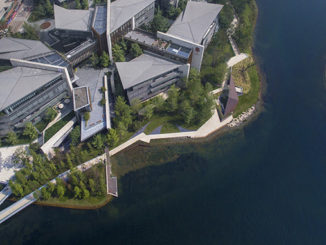Landscape Architecture As Applied to the Wants of the West was published in 1873 by JANSEN,
Cleveland starts the book in the preface with an objection to the using the term Landscape Architecture.
“Landscape Architecture” is objectionable, as being only figuratively expressive of the art it is used to designate. I make use of it, under protest, as the readiest means of making myself understood, in the absence of a more appropriate term. If the art is ever developed to the extent I believe to be within its legitimate limits, it will achieve for itself a name worthy of its position. Until it does so, it is idle to attempt to exalt it in the world’s estimation, by giving it a high – sounding title.
It is interesting that it seems the discussion of the definition of Landscape Architecture has continued since the early days of the profession, then the usage was to make the writer understood as what he was referring to whereas ironically today some are trying to change the term to make the public better understand what it landscape architecture (or land architecture or land design as some would have it.) Over the past 140
Cleveland begins the book by discussing the trend of houses in suburban areas that have come about through construction of railways, new
roads, branches and lines of horse cars and the
A man calls upon me for advice in regard to the arrangement of his
grounds, and tells me he has built his house and made various improvements by grading and clearing, and now wants me to tell him how to finish it off. On visiting his place I find, perhaps, that he has
placed his house in a position which may subject him to
inconveniences which had never occurred to him, or that
he might have secured advantages by placing it elsewhere
which are impossible where it is…….In other words, after destroying the natural beauty of the place, he looks to me to make it attractive by the introduction of artificial decorations, and not
unfrequently he proceeds to give me directions as to the kind of ornaments he would like, and where and how they are to be bestowed ; a fountain garishly displayed for the admiration of every wayfarer on the street……the idea throughout being that the place must be dressed up to look pretty, that the landscape gardener’s duty is simply to arrange the dressing, and the test of his skill consists in making the most elaborate display of such baby-house furniture as the owner is willing to pay for.
The proportion of those who have applied to me to arrange their grounds
from the outset, fixing the positions of the buildings, and adapting the various subdivisions to the natural features of the place, so as to secure the utmost convenience, with the best possible development of graceful or picturesque effect…
The above passages of the book provide sadly show us that the practice of calling upon landscape architects after the preliminary work is complete has occurred throughout our profession and will continue for years to come, it is only when we educate our allied professions (architecture, survey, urban planning) and the public about the value of landscape architecture that we will see the increase in invitations for preliminary work rather than come in at the end to “add the green” or “put the parsley on the pig”
Cleveland continues on writing about his dislike for the current situation and provides a definition of landscape architecture to be published in the public press.
“Landscape Gardening, or more properly Landscape Architecture, is the art of arranging land so as to adapt it most conveniently, economically and gracefully, to any of the varied wants of civilization.”
The above definition provides with a short succinct statement of landscape architecture at the time, of
Cleveland then elaborates on the skills of landscape architect
All these things are comprised in the essential duties of the landscape architect, independently of the artistic skill which enables him to preserve a unity of design throughout, and thus to give an expression of grace and beauty to the whole by the harmonious blending of its parts. The point I wish especially to impress upon the reader is that this primary work is what really confers character upon the place.
Here Cleveland provides with two key characteristics of design that as landscape architects we need to remember – the unity of design and character upon the place. Often we may be requested to change our design but adding elements however if the unity of the design is lost then we need to either educate the client or modify the design to maintain the unity. Secondly, our design often determines the character of the place, we need to ensure that we are not imposing a highly artificial or non-contextual design on the landscape.
Cleveland continues discussing the considerations required when siting a house including privacy, views, comfort, and program. He moves on to siting trees and how the inexperienced often place trees with five to six feet (1.5-1.8m) then once they have viewed the scale of other trees understand the need to call in an experienced person to provide import on their landscape. This is still true today if we observe residential gardens that are 15, 20, 35 years old they are often overgrown with trees that were planted too close without thinking about the mature scale, form, and size of the tree.
Cleveland in the next chapter moves on to landscape architecture applied to cities and the lack of consideration that has been given to the land and how city planning can benefit from the expertise of landscape architects.
…..towns grew into cities it was simply by the indefinite extension of the straight streets, running north, south, east or west, without regard to topographical features, or facilities of grading or drainage, and still less of any considerations of taste or convenience, which would have
suggested a different arrangement. Every Western traveler is familiar with the monotonous character of the towns resulting from the endless repetition of the dreary uniformity of rectangles which they present;
The above can be said of many cities in the western world and those of developing nations, the lack of understanding of topography and that not understanding the character of the place results in cities that often look so similar that there is little to differentiate them from their neighbours. Although there has been improvement the approach in many cities their is still a lack of awareness in new city planning and development.
Cleveland provides an evaluation of the design of Chicago at the time and some of the “unknown parks” such as Ellis Park and Lincoln Park. He goes into a long discussion about plans by Chicago for new parks on the edge of the city as appendages and how younger cities should have the forethought to ensure that “their parks and boulevards as integral portions of the city, instead of being merely ornamental appendages.” This is true today with new cities appearing in developing nations that they need to have the forethought to have parks and boulevards as a network rather than appendages or afterthoughts, and the same could be said of established cities seeking to build infill housing, there is a need to allocate space to ensure a network of green rather than small isolated parks, gardens or waterways.
Cleveland in Chapter 5 provides us with an insight that the concept of landscape architecture adding value to property has been applied even back in
Cleveland then moves onto a discussion around street trees and that cities should have their own nurseries with a city forester and the trees should be planted and subsequently cared from by a superintendent. This still occurs in many cities but has also been
In the final chapter, Cleveland discusses the movement west across the USA and the “priceless opportunity” of
No regard is paid to the topography of the ground; no reference is had to future interests or necessities of business or pleasure; no effort is made to secure the preservation of natural features which in time might be invaluable as a means of giving to the place a distinct and unique character.
In short, there is not the slightest recognition of the existence of such
an art as landscape architecture.
Cleveland then goes on to provide examples of San Francisco and Denver of cities that had no regard for topography and how their beauty could have been increased through paying attention to the landscape. Many cities across the world have lost or hidden the natural beauty of the landscape due to urban sprawl and transport infrastructure. It is key that landscape architects are part of the planning process to ensure that natural landscapes are not lost due to poor urban planning and urban design.
I have endeavored to convey my idea of the scope of the art of landscape architecture, and I do not think my general premises will be disputed. It cannot be denied that one mode of adapting the arrangement of a city, a
town or a private estate to the natural features of itssituation, may be preferable to another, as a means of securing the utmost convenience, in the most economical as well as the most attractive and graceful manner……It seems almost absurd that such a course of reasoning should be necessary in order to prove the existence of such
an art as landscape architecture, but while we continue to ignore its existence and to go on blindly and without method, in the performance of works which obviously should be based directly upon its principles…. The scientific discussion of the subject, (if the man could be found who is competent to it) would require a
volume of such compass as would be likely to repel the class of readers I have most desired to attract.
I agree with Cleveland’s idea that we need to continue to write about landscape architecture but in a way that doesn’t repel the reader (or class of readers), too often we fall into the crux of writing for our peers and not for the general reader, thus producing volumes of discussion that stays on bookshelves or hard drives without being read by but a mere few people.
What have we learnt from Cleveland and this book? Some could say that not much has changed. That landscape architects are still seeking recognition and continue to seek to design spaces with the character of the place with natural features.
We also need to remember the key principles of the profession and avoid providing an “elaborate display of such baby-house furniture as the owner is willing to pay for.” and look to provide landscapes that “adapt it most conveniently, economically and gracefully, to any of the varied wants of civilization. ” with a reference to the environmental and social impacts.
LANDSCAPE ARCHITECTURE, AS APPLIED TO THE WANTS OF THE WEST; BY H. W. S. CLEVELAND, Landscape Architect. is available for free through Google Books at https://goo.gl/XqmPdb
Article Written by Damian Holmes is the Founder and Editor of WLA.
He is also a registered Landscape Architect with extensive experience in Australia, Canada, and China.




